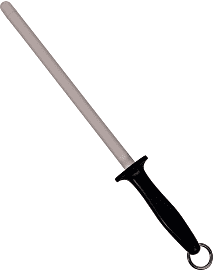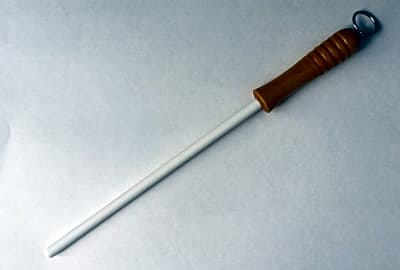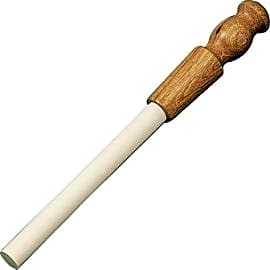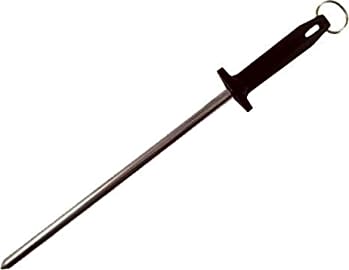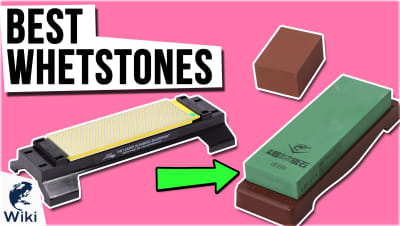The 9 Best Sharpening Steels

This wiki has been updated 23 times since it was first published in May of 2019. The sharper a knife, the safer and easier it is to use, but every cut causes an edge to go slightly out of true. Whether you use yours only occasionally or for hours each day, it's important to have the right honing rod to keep them sharp and ready to use at all times. These are some of the most effective tools for keeping kitchen knives and utility blades in peak condition. When users buy our independently chosen editorial choices, we may earn commissions to help fund the Wiki.
Editor's Notes
October 28, 2020:
We want to take a second to mention that these should be used with extreme caution with Japanese knives. If you're using a super high-end carbon-steel chef's knife, we highly recommend using a 1,000- and possibly a 6,000-grit whetstone instead, as that will be more effective and safer for the health of the blade's edge.
Overall, it's nearly impossible to top the Mac Black if you want something that can actually do real sharpening. If all you want is a honing rod - which is a tool that's not designed to sharpen anything - the Dexter Butcher is the top choice. The difference between the two is that a ceramic rod will actually remove metal from an edge and can turn dull knives into sharp ones, to a slightly lesser degree than the diamond-style tools that are more often found in workshops than kitchens. Honing rods, on the other hand, don't remove material, but simply straighten edges that have gone slightly out of true. To keep your working chef's knife in peak performance throughout the work day, regular honing is the way to go.
For most blades, though, many of these will do great. We added the Mercer M14412 because it's remarkably affordable for such a quality piece of equipment, which is something we can attest to as far as most Mercer products go. In fact, this one would make a good upgrade to the short, grooved models often sold with knife kits.
We also included the Arkansas Sharpeners AC4, partly because its wide diameter increases its effectiveness just slightly, at least when used on thick blades. It's not ideal for use in kitchens by novices, though, because it is quite heavy and has a slightly inconvenient flat tip. alternatively, if you're mostly concerned with pocket knives, a good knife sharpener might be the way to go.
May 06, 2019:
Before going any further, you may notice what we don't have on the list: any grooved steel rods. Quite frankly, those do not serve much of a purpose and nobody should ever buy them. They don't sharpen and they barely hone, but they can and do cause tiny microserrations in otherwise healthy blades and cause them to degrade more quickly. Next up, briefly, remember that honing and sharpening are very different things. Honing brings a slightly warped edge back into true by making it straight again, while sharpening physically removes material to create an entirely new edge.
With that clarified, the Mac Black is the most versatile around. A skilled chef can hone at any rate and sharpen with relative ease thanks to the ceramic material and grooved sides. The reasons this grooved option is okay are that 1) it's accompanied by a smooth side to finish the honing process and 2) it's geared towards professionals who tend to have more experience regarding the nuances of the task. For everyday use, the Dexter Butcher is hard to beat; this is one that you could safely use after every single kitchen task and it wouldn't damage the knife. If you just need something to get you by at work, check out the Pierre Bonnel, which isn't the very best quality, but it's cheap and effective. As for the Idahone, I've used one for years, and it's a little amusing how many times I've seen them in different cooks' and chefs' kits over that time. Just don't drop it, as it's pretty fragile, and its round handle doesn't like to stay in one place once it's set down. The Mundial is worth looking at if you're honing a small machete or similarly large knife, as it's important that your rod is longer than your blade. And the Cook's Standard and Smith are not to be used without extreme caution, as they can very easily damage a knife if you don't use them properly. They both take a lot of metal off a blade, and neither is meant for honing. As long as you know what you're getting into, though, they can be very effective tools for repairing damaged edges or bringing otherwise very dull knives back into circulation without dealing with actual sharpening stones, which require multiple hours of soaking in oil or water to work properly.
Special Honors
Lee Valley Tools Leather Strop As any professional sharpener or blade polisher knows, once the main honing process has begun, it's time to break out the strop. This particular model is of especially high quality and has a durable one-piece body with an integrated handle that makes it as easy to use as the steel rod it follows. leevalley.com




